With electric vehicles fast turning into a very practical proposition, we peek into the market to see what's out there...
Page 38
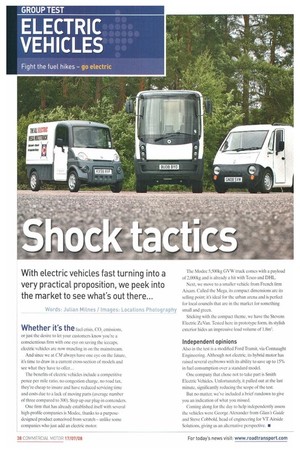
Page 39
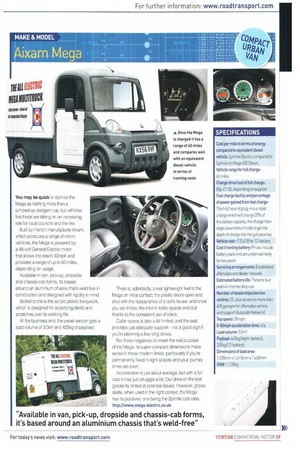
Page 40
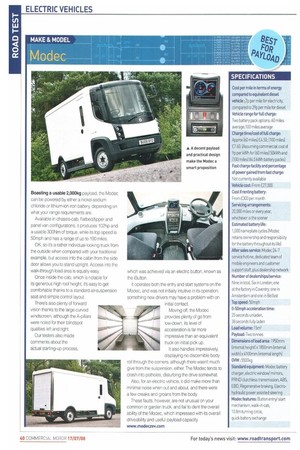
Page 41

Page 42
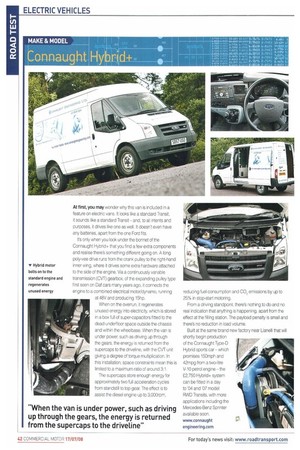
Page 43
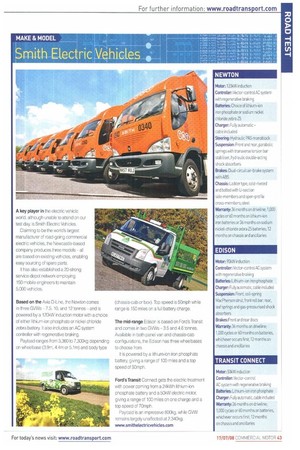
If you've noticed an error in this article please click here to report it so we can fix it.
Words: Julian Mitnes / Images: Locations Photography
Whether it's the fuel crisis. CO, emissions, or just the desire to let your customers know you're a conscientious firm with one eye on saving the icecaps, electric vehicles are now muscling in on the mainstream.
And since we at CM always have one eye on the future, it's time to draw in a current cross-section of models and see what they have to offer...
The benefits of electric vehicles include a competitive pence per mile ratio, no congestion charge, no road tax, they're cheap to insure and have reduced servicing time and costs due to a lack of moving parts (average number of three compared to 300). Step up our plug-in contenders.
One firm that has already established itself with several high-profile companies is Modec, thanks to a purposedesigned product conceived from scratch — unlike some companies who just add an electric motor. The Modec 5,500kg (WNW truck comes with a payload of 2,000kg and is already a hit with Tesco and DHL.
Next, we move to a smaller vehicle from French firm Aixam. Called the Mega, its compact dimensions are its selling point; it's ideal for the urban arena and is perfect for local councils that are in the market for something small and green.
Sticking with the compact theme, we have the Stevens Electric ZeVan. Tested here in prototype form, its stylish exterior hides an impressive load volume of 1.8e.
Independent opinions
Also in the test is a modified Ford Transit, via Connaught Engineering. Although not electric, its hybrid motor has raised several eyebrows with its ability to save up to 15% in fuel consumption over a standard model.
One company that chose not to take part is Smith Electric Vehicles. Unfortunately, it pulled out at the last minute, significantly reducing the scope of the test.
But no matter, we've included a brief rundown to give you an indication of what you missed.
Coming along for the day to help independently assess the vehicles were George Alexander from Glass's Guide and Steve Cobbold, head of engineering for VT Airside Solutions, giving us an alternative perspective. IN There is, admittedly, a real lightweight feel to the Mega on initial contact: the plastic doors open and shut with the reassurance of a doll's house, and once you are inside, the interior looks sparse and dull thanks to the consistent use of black.
Cabin space is also a bit limited, and the seat provides just adequate support — not a good sign if you're planning a few long drives.
But these negatives do mask the real purpose of the Mega. Its super-compact dimensions make sense in these modern times, particularly if you're permanently fixed in tight spaces and your journey times are short.
Acceleration is just about average, but with a full load it may just struggle a bit. Our drive on the test gradients hinted at potential issues. However, gripes aside, when used in the right context, the Mega has its positives; one being the 2p/mile cost ratio. http://www.mega-electric.co.uk
Boasting a usable 2,000kg payload, the Modec can be powered by either a nickel-sodium chloride or lithium-ion iron battery, depending on what your range requirements are.
Available in chassis-cab, flatbed/tipper and panel van configurations, it produces 102hp and a usable 300Nm of torque, while its top speed is 50mph and has a range of up to 100 miles.
OK, so its a rather individual-looking truck from the outside when compared with your traditional example, but access into the cabin from the side door allows you to stand upright. Access into the walk-through load area is equally easy.
Once inside the cab, which is notable for its generous high roof height, it's easy to get comfortable thanks to a standard air-suspension seat and simple control layout.
There's also plenty of forward vision thanks to the large curved windscreen, although the A. pillars were noted for their blindspot qualities left and right.
Our testers also made comments about the actual starting-up process, which was achieved via an electric button, known as the iButton.
It operates both the entry and start systems on the Modec, and was not initially intuitive in its operation; something new drivers may have a problem with on initial contact.
Moving off, the Modec provides plenty of go from low-down, its level of acceleration is far more Impressive than an equivalent truck on initial pick up.
It also handles impressively, displaying no discernible body roll through the corners, although there wasn't much give from the suspension, either. The Modec tends to crash into potholes, disturbing the drive somewhat.
Also, for an electric vehicle, it did make more than minimal noise when out and about, and there were a few creaks and groans from the body.
These faults, however, are not unusual on your common or garden truck, and fail to dent the overall ability of the Modec, which impressed with its overall driveabilly and useful payload capacity. www.modecrev.com
If the Aixam Mega is small, then the ZeVan from Stevens Vehicles is the next step. Seen here in prototype form, its compact dimensions disguise a usable 1.8m3 load volume and 450kg of payload.
The company is making some bold statements regarding viability including the claim that the van will pay for itself in two years when factors such as fuel, road tax and congestion charge exemption, servicing and parking costs are taken into consideration.
Since this was a prototype, the interior was stark in its design, but the fundamentals are there. There is decent cabin space, but actual access fell short of the mark thanks to its small doors.
It was a perky performer once it was up and running, pulling strongly up to its top speed of 50mph and remaining fairly quiet when running around the test track, though inner-city conditions may prove influential. Cornering was also reassuringly stable. although the structural design didn't leave much in the way of crash protection. Access to the rear is provided by twin-split doors, which opened out fully, and the near-cube design allowed good utilisation of the space Due to the condition of this particular example, it was quite difficult to formulate an overall impression, but if the interior is smartened up and a degree of robustness added, the ZeVan's potential could be realised.
www.stevens-vehicies.co.uk
At first, you may wonder why this van is included in a feature on electric vans. It looks like a standard Transit, it sounds like a standard Transit and, to all intents and purposes, it drives like one as well. It doesn't even have any batteries, apart from the one Ford fits.
It's only when you look under the bonnet of the Connaught Hybrid+ that you find a few extra components and realise there's something different going on. A long poly-vee drive runs from the crank pulley to the right-hand inner wing, where it drives some extra hardware attached to the side of the engine. Via a continuously variable transmission (CVT) gearbox, of the expanding pulley type first seen on Oaf cars many years ago, it connects the engine to a combined electrical motor/dynamo, running at 48V and producing 15hp.
When on the overrun, it regenerates unused energy into electricity, which is stored in a box full of super-capacitors fitted to the dead underfloor space outside the chassis and within the wheelbase. When the van is under power, such as driving up through the gears, the energy is returned from the supercaps to the driveline, with the CVT unit giving a degree of torque multiplication. In this installation, space constraints mean this is limited to a maximum ratio of around 3:1.
The supercaps store enough energy for approximately two full acceleration cycles from standstill to top gear. The effect is to assist the diesel engine up to 3,000rpm,
reducing fuel consumption and CO2 emissions by up to 25% in stop-start motoring.
From a driving standpoint, there's nothing to do and no real indication that anything is happening, apart from the effect at the filling station. The payload penalty is small and there's no reduction in load volume.
Built at the same brand new factory near Llanelli that will shortly begin production of the Connaught Type-D Hybrid sports car which promises 150mph and 42mpg from a two-litre V-10 petrol engine-the £2,750 Hybrid+ system can be fitted in a day to '04 and '07 model RWD Transits, with more applications including the Mercedes-Benz Sprinter available soon. www.connaught engineering.com
Based on the Avia 0-Line, the Newton comes in three GVWs• 7.5, 10, and 12 tonnes — and is powered by a 120kVV induction motor with a choice of either lithium-ion phosphate or nickel chloride zebra battery. It also includes an AC system controller with regenerative braking.
Payload ranges from 3,360 to 7,300kg depending on wheelbase (3.9m, 4.4m or 5.1m) and body type (chassis-cab or box). Top speed is 50mph while range is 150 miles on a full battery charge.
The mid-range Edison is based on Ford's Transit and comes in two GVWs —3.5 and 4.6 tonnes. Available In both panel van and chassis-cab configurations, the Edson has three wheelbases to choose from.
It is powered by a lithium-ion iron phosphate battery, giving a range of 100 miles and a top speed of 50m ph.
Ford's Transit Connect gets the electric treatment with power coming from a 24kWn lithium-ion phosphate battery and a 50kW electric motor, giving a range of 100 miles on one charge and a top speed of 70mph.
Payload is an impressive 800kg, while GVW remains largely unaffected at 2,340kg, www.smithelectricrehicles.com












































































































































































